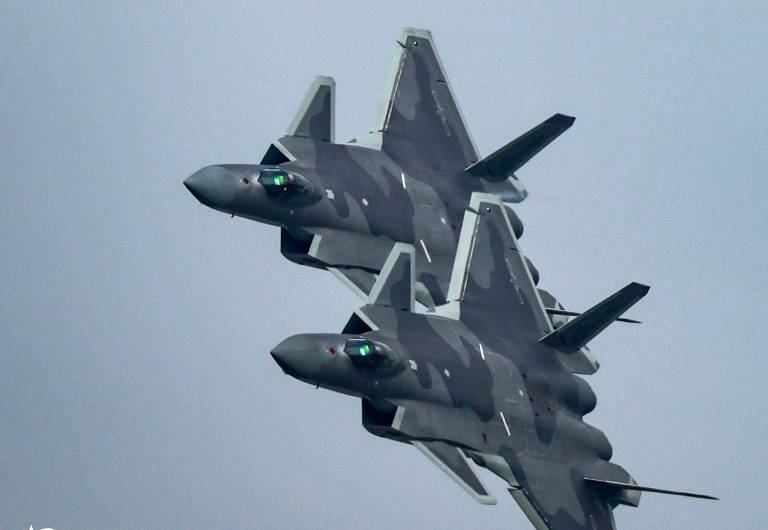It would seem: a space power, develops and builds modern military equipment, and so on. Yes, that's right. And there are design bureaus, and there are factories. But there are also nuances.
We will not touch Chinese tanks and ships now, these are generally separate songs, but we will talk about airplanes.
The Chinese army has planes. And with their release everything seems to be fine, but ... But there is a problem. And it is in the engines.
Only a fool would argue that China is developing quite modern aircraft. In general, this country has made a huge leap forward in development. Some 50 years ago, who could have said that China would master not only the production, but also the development of its own tanks, aircraft and ships? Yes, with the help from the outside, "distorting" everything that is possible, but it is difficult here only first.
And there is nothing wrong with copying and borrowing. Our first strategic bomber was also not quite a Tu-4, but very much even a B-29. Until the nut. Nothing, it was easier further.
Therefore, no one makes a secret of the fact that virtually all Chinese developments in aviation are the fruits of borrowing from other countries, and not always with their consent. Many "helped", and, for example, we - and without quotes. They just helped with drawings and technologies. The Ukrainians also helped when they sold the "Varyag" with "accidentally" lying around in the holds of the Su-33 ... Many people helped.
Well, the Chinese intelligence should be applauded. Well done. They know how to work.
But the main problem is that aviation is a very complex thing. And not everything there can be simply taken and stuffed into a copier. Alas. For example, jet engines.
After all, it came to the ridiculous. China has long offered its planes to its neighbors in the region. Yes, very good avionics. Good performance characteristics. And the price is just a masterpiece. Well, like everything Chinese. But the trouble is - buyers refuse. They say - put the Russian engines - we'll tear them off with our hands. And with yours somehow there is no desire.
There is a problem with Chinese engines. Although they say (the Chinese themselves, it is true) that in terms of performance characteristics they are quite good and "in no way inferior" to either Russian or American, but there is a problem. This is a motor reliability. It is so low that it is possible to operate such aircraft ... China. Because these engines can be stamped like "Cherry Tiggo" and even more. And change like gloves.
But for money, but in another country ... No, not profitable.
After all, an airplane, like a tank, especially one bought for real money, should not break down at all. In theory, of course.
That is why Chinese manufacturers have a problem, and this problem is purely technological. And it lies solely in the lack of the necessary experience and knowledge of Chinese engineers.
For example, in the production of turbine blades.
It would seem what a simple thing, but no! It is this “simple” component that is the stumbling block for the Chinese. Doesn't come out of the copier normally, even if you crack.
It's technology, yes. If there were a plant on the territory of the PRC, it would be easier. You know, as soon as Canon built a lens manufacturing plant in China, the same factory, but Yongnuo, stood across the street very quickly. And a lens from Canon, say, 50 mm costs 10 thousand rubles, and "the same", but Yongnuo - 6.5. And you can't tell how they were assembled on the same conveyor.
But, for example, lenses with a variable focal length in the PRC are not yet made. Is it clear why? Do not know how.
It's the same with engines. Do not know how. And the partners, neighbors, allies, who know how, but do not want to share, are to blame for this. For example, Russia.
Yes, Russia does not want to share the secrets of the AL-31F production. Buy, gentlemen, a Su-35 with these engines, and you will be happy. No - well, you have a WS-10C. Which is "no worse".
In fact, it is much worse in terms of the reliability. And for some reason their J-16 fighter with this engine is good for everyone compared to the Su-35. Except for range and reliability.
Indeed, the J-16 is a fine generation 4 aircraft with a lot of advantages.
Avionics, radars, navigation, everything is beautiful. Except for the engine. And all the work that the Chinese engineers did on the Su-30MKI went downhill. Corkscrew.
It is precisely the technologies that are needed that will make it possible to make engines manufactured in the PRC really no worse than Russian or American ones. But here it is obvious that the entire structure responsible for new developments for the PLA lacks basic experience and knowledge.
Meanwhile, the problem is also affecting the Chengdu J-20, the fighter of tomorrow. The Great Dragon is a really beautiful plane. In reality, an indicator that China will soon be able to claim to declare itself as a country capable of developing and selling world-class military equipment.
And the situation with the J-20 is about the same as we have with the Su-57. The engine is there, but ... but it's still the same WS-10, albeit an upgraded one. Because the WS-15, on which the entire calculation for the J-20 was based, did not just fail the tests, but with special effects.
Yes, the explosion of the engine during ground tests showed that the WS-15 is frankly unreliable, and Chinese engineers have not yet been able to solve this problem. On the one hand, the problem is simple: “insufficient quality control of monocrystalline turbine blades”.
I'm sure the Chinese have control over everything. And the gaps in something else, in that they simply did not learn how to grow monocrystals of the required quality. Technology in all its glory.
It is the quality that is how they know how to grow monocrystals in China. The only question is the technological level of the crystal, and hence the durability of the blades, which are made of monocrystalline tubes.
However, we will definitely talk about pipes separately, the topic is worth it.
Considering the eternal problems of China with its neighbors (which was shown well by the demonstration of fangs with India) and the sending of the J-20 as a demonstration somewhere in the Himalayas and on the coast, closer to Japan, the rate on this plane becomes clear. Hence, there is simply a desperate need for a reliable and powerful engine. Which China does not yet have.
It is clear that Chinese enterprises and organizations of a corresponding nature are working on the problem day and night, but here time is playing against our neighbors.
And there is little that can be done quickly. Yes, China has succeeded in copying and improving what was copied, but here we have a dead end. If, at the level of engineers and designers that China has today, it was possible to simply copy Russian technologies based on the same Su-30, the Chinese would certainly do this as quickly and clearly as possible.
But there is such a level of technology that alas. I must say that the Yakovlev Design Bureau faced about the same problem at one time, when the Americans did not share the technology for baking the wing for the MC-21. And the "domestic" liner got up without an American wing.
For three years, a group of engineers has been sitting in Voronezh at VASO and transferring tons of resin, thickeners and hardeners together with kilowatts, trying to achieve the desired result. But so far there is no wing and it is not clear when it will be.
This is a delicate matter. There are too many factors at play. Therefore, the Chinese developers also fail.
Well, why our people are not eager to share is also understandable. Neighbors, allies are today. And how it will turn out tomorrow is not clear. So the pipeline is great, voting in the UN is also great, but the technology of baking turbine blades is better to be held back.
Therefore, Russia prefers to impose the purchase of its best engines inside its own aircraft. It is both more expensive and makes copying difficult. Anyway, who said that the ability to copy and the ability to create something new are one and the same?
Meanwhile, Shenyang WS-10, which seems to be "no worse" than AL-31F, what is it? This is a copy of the US-French CFM56 engine, which in turn is a further development of the General Electric F101 engine developed for the B-1 Lancer.
Meanwhile, Shenyang WS-10, which seems to be "no worse" than AL-31F, what is it? This is a copy of the US-French CFM56 engine, which in turn is a further development of the General Electric F101 engine developed for the B-1 Lancer. It's a good engine that has been worn by bombers since 1970.
And CFM56 can't be a bad engine. Since 1982, he has not lifted anyone into the sky. But how much better their Chinese copy of WS-10 is, you know, that is another question. And the fact that the Chinese claim that it is no worse than the AL-31F ... Well, in general, you can say anything you want. We also say that the Sukhoi Superjet is a Russian aircraft, but in reality everything is somewhat different.
So it's not enough to copy the drawings. It is necessary to know even before rivet what is made of what and to be able to repeat it. An aircraft engine is a very difficult thing, I repeat. It is not for nothing that only four countries (USA, Russia, Great Britain and France) can produce aircraft engines from the beginning to the end of the technological chain. Yes, China claims to be the fifth country. But for this it is necessary to overcome a number of problems, which will have to kill a lot of time and brains.
China will continue to strive to solve its problems by all available methods. From honest buying to outright espionage. This is understandable, this is normal. But honestly, it will not always work out, this is confirmed by the facts. For example, the United States through its channels thwarted the deal of the Chinese state-owned company Skyrizon to acquire a controlling stake in the Ukrainian Motor Sich.
The developments of Motor Sich could be of great use to the Chinese, but ... not everyone in the world wants to observe the same Chinese aircraft on the market.
So it remains to do everything in our power to bring the WS-15 to condition, install it on the J-20, and then, perhaps, this aircraft will be able to compete (as the Chinese claim) with the F-22 and F-35. But this will have to solve the problems with single crystals and complex operations associated with metal processing.
But the biggest problem is that with China today (and tomorrow), hardly anyone wants to share technological secrets. The costs of a big policy based on the over-entrepreneurial spirit of the Chinese copying everything.
Проблемы в военно-промышленном комплексе – это действительно изрядная головная боль для той страны, у которой есть свой ВПК. Когда нет – тут и проблем нет, объявляй тендеры на закупку, сталкивай лбами разных производителей и выбирай по соотношению цена/качество то, что тебе приемлемо и выгодно. Но

topwar.ru



